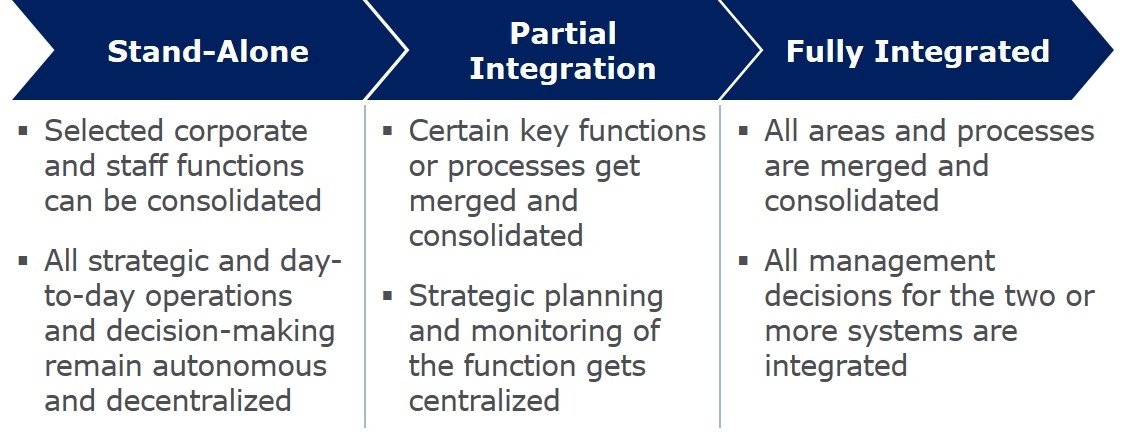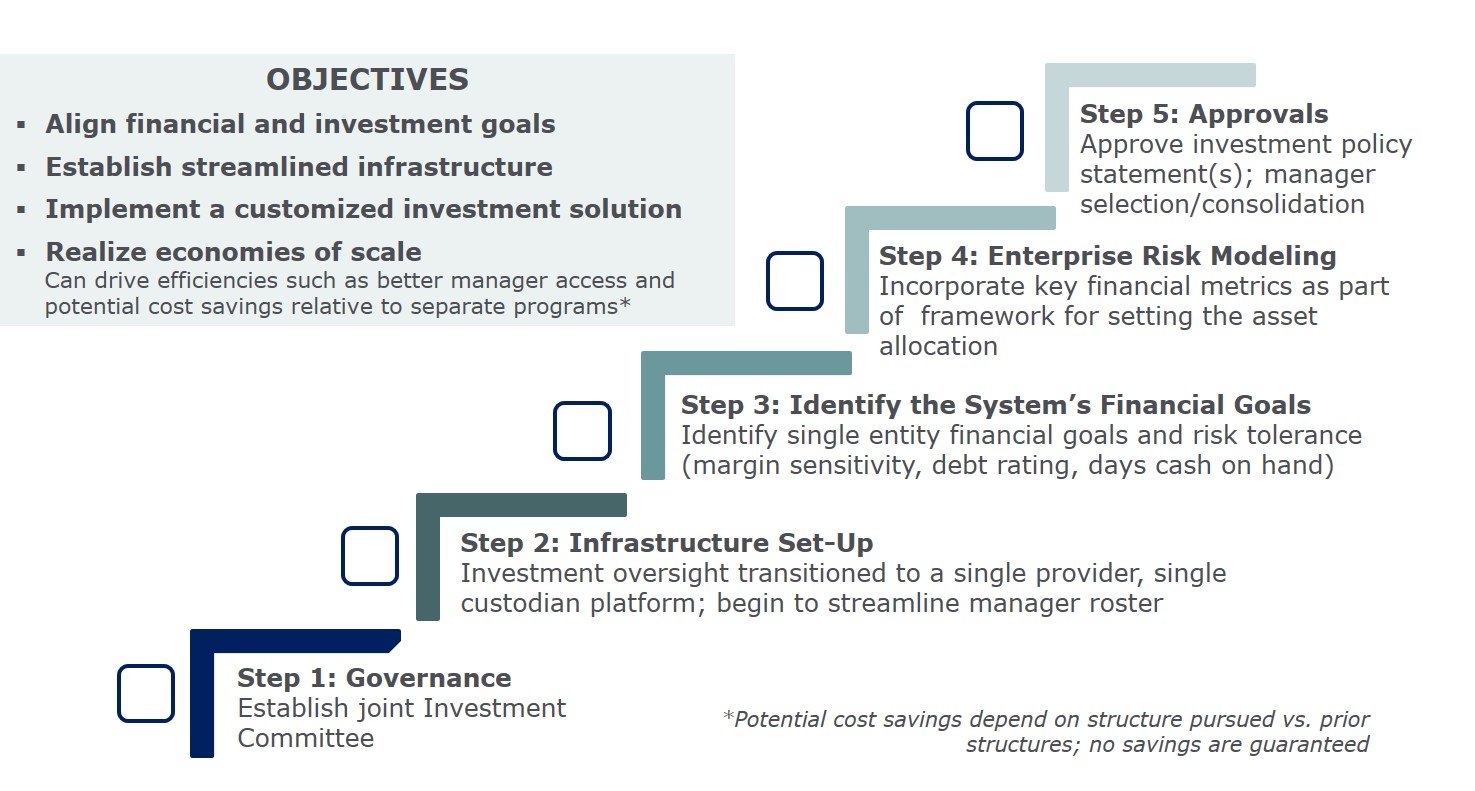If you’re in the healthcare industry, it’s likely you have been involved in a merger (or three). Merger and Acquisition (M&A) activity has long been prevalent in the healthcare industry as a path to drive financial and clinical efficiencies. However, there’s one potential benefit that gets little attention: the efficiencies that can be achieved by combining investment programs.
NEPC has worked alongside several healthcare systems as they have navigated complex mergers, consolidations, and/or acquisitions. This guide will discuss some of the advantages and challenges of these mergers, with a particular focus on how healthcare systems can ensure they are taking the right steps to optimize their investment programs along the way.
The Success Shortlist – Laying the Groundwork for Implementation
Every merger triggers a litany of operational challenges as
Exhibit 1: Spectrum of IntegrationYour new entity’s vision will vary depending on the type
|
healthcare systems must combine their physical, human and technological assets. The legacy organizations need agreed-upon strategic priorities and timelines that allow for adaptation – and that should include the investment programs.
Early development and adoption of the integration plan is crucial so that execution can begin soon after the deal is closed. Detailed below are several key decisions on investment programs that we believe contribute to a successful merger.
- Start from a shared vision. Building consensus among participating organizations on key strategic considerations is important. This critical first step is also a prudent time to decide on investment directives and goals for the combined entity, such as incorporating Diversity, Equity and Inclusion (DEI) and/or environmental, social and governance (ESG) factors into the investment process.
- Affirm governance structure. Establishing the appropriate governance structure and roles and responsibilities among the investment committee, staff and investment consultant are vital to achieve success. For example:Investment Committee: Determine the overall size of the committee and clarify who has authority over select areas/topics. Document the roles for the board and/or finance committees, as well as which decisions (such as asset allocation and selection of investment consultant) will be made by the committee and which (such as manager selection) by the staff or investment consultant.Staff: Determine staffing structure carefully because it may be the most important investment-related decision you make in generating efficiencies. You’ll need to determine who will lead the investment function, the size of the staff, and which decisions the staff will make. In our experience, turnover in leadership personnel is a key risk in any type of M&A transaction, but it can become acute in a full-integration merger (Exhibit 1). The more quickly the staffing structure can be identified, the greater the probability of maintaining stability in this key area. Postponing this decision or maintaining duplicate staff for an undefined time can be stressful for all parties involved and could delay achieving some of the merger goals.
Investment Consultant: Identify whether you want a single consultant to handle all aspects of the investment program, or multiple specialists. Also, choose how you want to engage the consultant – do you prefer them to take on a traditional advisory role, or to act in an outsourced chief investment officer (OCIO) capacity? Numerous factors must be weighed in this decision, including the organization’s desired level of involvement and availability and skills of internal resources (staff).
- Integrate the custodian. The custodian may not seem like a critical consideration in a healthcare merger, but failure to determine the appropriate structure, for instance, unitized accounting or a pooled structure, may become a source of lengthy delays within the merger timeline. We advise clients to make decisions about integrating the custodian right after selecting the investment consultant. Doing so can bring to the surface any issues related to the location of assets, the authority over those assets, and how gains and losses will be allocated to affiliated entities – before they impact your merger timeline.
- Document the governance structure. Codifying the governance structure is a critical step to ensure that the roles and responsibilities of all parties are clearly outlined, understood and verifiable. This is typically achieved by adopting an investment policy statement for each underlying plan and/or an investment charter for the combined organization. The development of these documents can be modeled from prior documents of the merging entities and/or samples provided by the investment consultant.
- Document and communicate. Remarkably, clearly conveying your plan of action to all stakeholders often falls through the cracks. Our experience indicates that communication and frequent updates outlining the vision and projected timeline early in the process significantly reduce future bottlenecks. After every meeting, document what was reviewed, what was agreed on, and what next steps are required. These simple steps can help keep the consolidation on its timeline.
- Delegate. Identifying support member roles and streamlining the decision-making process may be helpful in alleviating the heavy workload placed on key personnel. For example, delegating manager selection to a small investment sub-committee, staff and/or investment consultant may free up valuable time for board and investment committee members.
A Step-by-Step Framework for Adding Value Through Implementation
Many of NEPC’s healthcare clients have undertaken M&A activities; our role is primarily focused on providing investment recommendations for the combined entity and helping facilitate the process. To do that job well, we’ve developed our OneSystem Framework to guide clients through an integration plan that generates immediate benefits while setting up the organization for long-term success. We believe there are many advantages to following the framework outlined below (Exhibit 2).
Exhibit 2: NEPC’S Proprietary OneSystem Framework
- Immediate consolidation gains. Combining investments into a smaller number of investment providers can often lead to meaningful cost savings and institutional price breaks. An illustration of these gains is reflected in Exhibit 3 below, which highlights potential cost savings across custody and investment management fees. Additional cost savings may be generated by leveraging a transition manager and/or existing investment managers to guide the organization through the portfolio consolidation process. A key learning from our past work with clients is that early realization of efficiencies is possible, provided the governance structure and decision-making authority have been established.
- A clearer view of risk. NEPC believes conducting a comprehensive financial risk assessment (or enterprise risk assessment) is a critical early step to helping assess the combined organization’s overall risk profile, and its ability to take risk in the investment portfolio(s). NEPC’s Enterprise Risk Model (ERM) links asset portfolios, operating objectives, debt financing and rating agency considerations as a critical step in our portfolio construction process. The insights generated from this analysis inform vital decisions relating to investment exposures, debt consolidation (or debt retirement) and pension risk.
- Planning structures that reduce long-term costs. NEPC’s OneSystem Framework cultivates efficiencies by thoughtfully streamlining financial structures. For example, master trusts can be established for larger healthcare systems integrating smaller affiliated hospitals, thereby creating a framework that can be leveraged for future integration efforts. This approach has proven to generate long-term time savings for staff, which are realized during each subsequent consolidation event.
Measuring and Reporting Success
One of the advantages of focusing on financial and investment considerations early on in a consolidation process is that it allows for the opportunity to swiftly quantify gains. Those gains can then be measured and reported to boards, investment committees and business leaders, often at critical junctures during an integration effort. These tangible wins can boost morale and sustain the energy needed to tackle other complex challenges that lie ahead. The illustration below reflects an actual outcome of NEPC’s work in partnership with a healthcare client.
Exhibit 3: Creating a Simpler, More Efficient Investment Structure
NEPC works alongside CFO’s and staff to simplify the investment program. Our consolidation process typically leads to fee breaks with custodians and managers by streamlining assets.
CONCLUSION
There has been a lot written about how M&A can achieve valuable efficiencies of scale when it comes to, for example, the high costs of information technology and personal protective equipment. Much less is written on achieving synergies among the investment portfolios. This is an oversight. As an experienced investment consultant for numerous major health systems, we have seen compelling evidence that financial and investment gains can be among the easiest, and earliest, to achieve in a consolidation. If your organization has discussed the possibility of a merger or acquisition, reach out to your NEPC consultant or Kevin Novak and Nedelina (Nina) Petkova to see how our intuitive checklist, sample case studies, and our models and tools can help you achieve success.
NEPC, LLC is an independent investment consultant and private wealth advisor, serving 391 retainer clients and $1.1 trillion in total assets. Combining a proprietary research team dedicated to the long-term challenges facing investors with our unique client-centric model, NEPC builds forward-looking investment portfolios for healthcare institutions. NEPC currently consults to over 45 healthcare organizations representing over $110 billion in plan assets. Over 40% of our Healthcare clients have been part of M&A activity in the last 5 years. To learn more about NEPC’s healthcare team and how we can help you, please visit NEPC.com.






